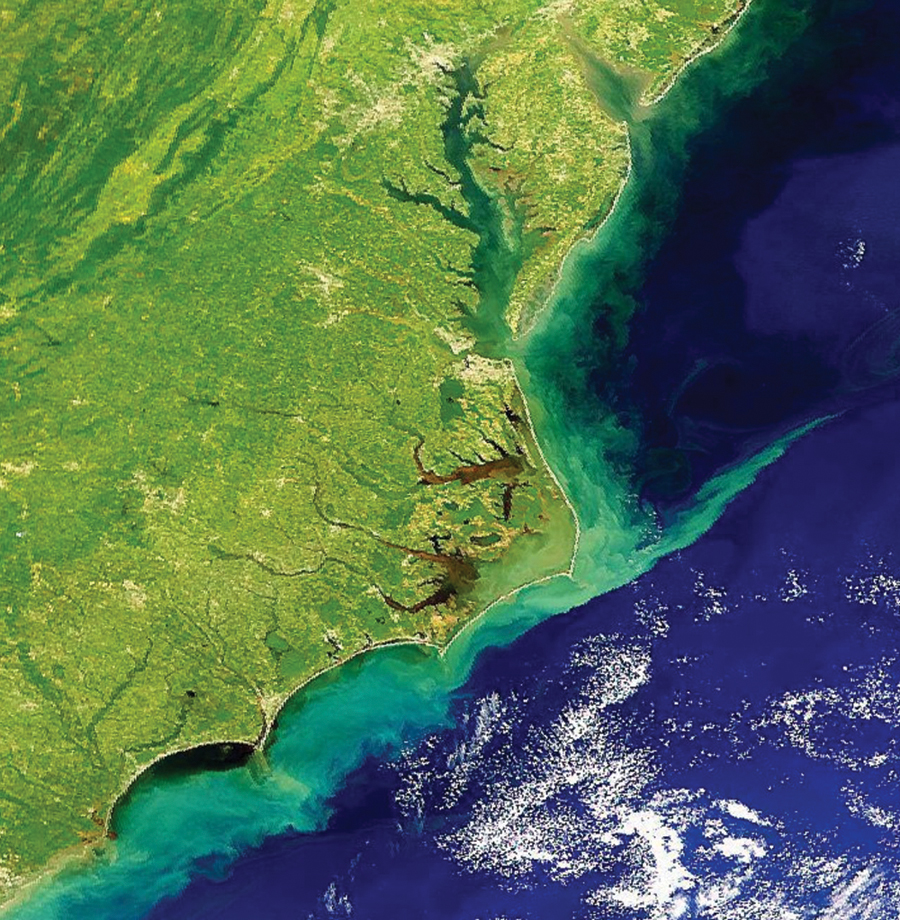A River Runs Into It
As climate change ensues, springtime plumes of acidic river water may add further stress to coastal ocean creatures
FOR SOME FIVE YEARS, researchers from the Ocean Process and Analysis Laboratory have been faithfully going to sea at least once a month to take measure of the waters along two transects: from Portsmouth Harbor up to the mouth of Maine’s Kennebec River, and from Portsmouth out to the Wilkinson Basin in the Gulf of Maine.
The effort has generated a wealth of unique data that will, among other things, help scientists monitor how sea life will fare in warmer, more acidic waters as global warming continues and atmospheric carbon dioxide levels rise. One particular concern is how increasingly acidic waters will impact shellfish and, in turn, the related $1.6 billion U.S. industry.
Shellfish larvae, including those of lobsters, clams, mussels, and scallops, begin their lives in shallow coastal waters where they must begin building their protective shells immediately. They do so by pulling calcium carbonate out of seawater. But as seawater becomes more acidic the critical ingredient is in shorter supply as it is used to buffer (make more alkaline) the water itself. Indeed, if the acidity level exceeds a certain threshold shells begin to disintegrate.
The five-year dataset collected by OPAL scientists, including research assistant professor Joe Salisbury, clearly show that both carbon dioxide and acidity have risen modestly in seawater sampled over that period. The data also show that a specific, crystalline form of calcium carbonate, aragonite, used by many shellfish drops to very low levels at certain times of the year.
“The levels of aragonite were low in general but even lower than expected in springtime,” notes Salisbury, “so we looked more carefully at the data with respect to springtime river plumes, which we know are acidic relative to the receiving ocean waters.”
Analysis of Kennebec River data uncovered episodes where acidic water with very low levels of aragonite had indeed occurred. And, as bad luck would have it, these acidic plumes can coincide just as shellfish larvae are making a go of it in shallow coastal waters. Should prevailing winds and currents cause a river plume to hug the coastline rather than push it further offshore, the shellfish larvae will be swimming in an acid soup devoid of aragonite.
All of which is not good news for the Gulf of Maine’s $450-million-per-year shellfish industry.
Salisbury, along with OPAL colleagues Chris Hunt and Janet Campbell and Mark Green of Saint Joseph’s College, wondered if these conditions observed in the western Gulf of Maine might be occurring elsewhere around the globe.
Writing in a paper published on the topic last December in the American Geophysical Union’s EOS Transactions, Salisbury et al. noted that while many of the world’s rivers are acidic and nearly all have aragonite levels that are lower than the ocean water they discharge into, little is known about the relationship between discharge, low aragonite in coastal waters, and the potential negative impact on early stages of early shellfish development.
In EOS Transactions the team identified areas in need of further investigation relative to this topic and stated that the Arctic and sub-Arctic coastlines were the priority regions. These are areas with cool temperatures, which further suppress the already low aragonite levels, and dramatic increases in river discharge due to global warming. “The combination of these factors could have severe consequences for high-latitude calcifying organisms, particularly shelled pteropods, which contribute to the diet of commercially important species including salmon, herring, cod, and mackerel,” the authors wrote.
The effort has generated a wealth of unique data that will, among other things, help scientists monitor how sea life will fare in warmer, more acidic waters as global warming continues and atmospheric carbon dioxide levels rise. One particular concern is how increasingly acidic waters will impact shellfish and, in turn, the related $1.6 billion U.S. industry.
Satellite image of Cape Fear River in North Carolina from NASA's Sea-viewing Wide Field-of-view Sensor (SeaWiFS).
Image courtesy of NASA |
Shellfish larvae, including those of lobsters, clams, mussels, and scallops, begin their lives in shallow coastal waters where they must begin building their protective shells immediately. They do so by pulling calcium carbonate out of seawater. But as seawater becomes more acidic the critical ingredient is in shorter supply as it is used to buffer (make more alkaline) the water itself. Indeed, if the acidity level exceeds a certain threshold shells begin to disintegrate.
The five-year dataset collected by OPAL scientists, including research assistant professor Joe Salisbury, clearly show that both carbon dioxide and acidity have risen modestly in seawater sampled over that period. The data also show that a specific, crystalline form of calcium carbonate, aragonite, used by many shellfish drops to very low levels at certain times of the year.
“The levels of aragonite were low in general but even lower than expected in springtime,” notes Salisbury, “so we looked more carefully at the data with respect to springtime river plumes, which we know are acidic relative to the receiving ocean waters.”
Analysis of Kennebec River data uncovered episodes where acidic water with very low levels of aragonite had indeed occurred. And, as bad luck would have it, these acidic plumes can coincide just as shellfish larvae are making a go of it in shallow coastal waters. Should prevailing winds and currents cause a river plume to hug the coastline rather than push it further offshore, the shellfish larvae will be swimming in an acid soup devoid of aragonite.
All of which is not good news for the Gulf of Maine’s $450-million-per-year shellfish industry.
Salisbury, along with OPAL colleagues Chris Hunt and Janet Campbell and Mark Green of Saint Joseph’s College, wondered if these conditions observed in the western Gulf of Maine might be occurring elsewhere around the globe.
Writing in a paper published on the topic last December in the American Geophysical Union’s EOS Transactions, Salisbury et al. noted that while many of the world’s rivers are acidic and nearly all have aragonite levels that are lower than the ocean water they discharge into, little is known about the relationship between discharge, low aragonite in coastal waters, and the potential negative impact on early stages of early shellfish development.
In EOS Transactions the team identified areas in need of further investigation relative to this topic and stated that the Arctic and sub-Arctic coastlines were the priority regions. These are areas with cool temperatures, which further suppress the already low aragonite levels, and dramatic increases in river discharge due to global warming. “The combination of these factors could have severe consequences for high-latitude calcifying organisms, particularly shelled pteropods, which contribute to the diet of commercially important species including salmon, herring, cod, and mackerel,” the authors wrote.
by David Sims, Science Writer, Institute for the Study of Earth, Oceans, and Space. Published in Winter 2009 issue of EOS .

